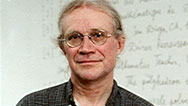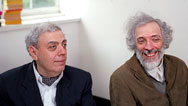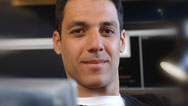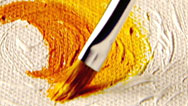Profile: Brothers Chudnovsky
- Posted 07.26.05
- NOVA scienceNOW
(This video is no longer available for streaming.) Watch how two brilliant and eccentric Russian number theorists, the Chudnovsky brothers, tackle a math problem so large it draws comparisons to analyzing the human genome. The problem involves stitching together fractured images of one of the most beautiful and complex works of art to survive from the Middle Ages—seven famous tapestries known as "The Hunt of the Unicorn" housed at the Metropolitan Museum of Art. The brothers attempt to solve the visual puzzle using a home-made supercomputer built with parts from Home Depot.
Transcript
PROFILE: BROTHERS CHUDNOVSKY
PBS Airdate: July 26, 2005
ROBERT KRULWICH: Whenever a museum wants to really examine a masterpiece, get in close enough to see the hidden details, the brushstrokes, the really teeniest of gestures, what they can do is they can divide the painting into imaginary squares, small, small squares. And then they can take detailed digital photographs of each segment. And then they can patch all the photos together into an exquisitely detailed whole for scholars all over the world to study. This isn't hard. It's actually kind of easy.
But suppose instead of a painting, suppose you're photographing a unicorn stitched out of thousands and thousands of fibers. We're talking here about a tapestry. Now to put the unicorn pictures back together is a puzzle of such enormous difficulty you would need a supercomputer to do this right. And not just a supercomputer, you'd need a couple of guys we know in Brooklyn.
Correspondent Chad Cohen reports.
GREGORY CHUDNOVSKY ( Polytechnic University): And of course, we cannot go back to just one bit, and another is to have two bits at a time, so we definitely...at least 50 percent or more significance.
CHAD COHEN (Correspondent): The sound of equations blends with the hum of New York City traffic, as these two world class mathematicians make their way to their lab at the Brooklyn Polytechnic University.
Gregory and David Chudnovsky seem to have a never ending conversation about their passion for numbers. It's been that way since their childhood days in Kiev, where younger brother, Gregory, developed myasthenia gravis, a crippling neuromuscular disease.
David has always been there to help, and since emigrating from Ukraine in 1978, the pair have been inseparable.
GREGORY CHUDNOVSKY: No.
DAVID CHUDNOVSKY (Polytechnic University): No.
CHAD COHEN: Oh, for the paper.
DAVID CHUDNOVSKY: Yeah, paper consists of already grades...
CHAD COHEN: Between their math-speak and Russian accents, conversation with the brothers can be a challenge. Thoughts come to them rapidly, so rapidly they often complete each other's sentences.
GREGORY CHUDNOVSKY: It simply becomes nothing. You take a difference...
DAVID CHUDNOVSKY: Nothing or a small, small...
GREGORY CHUDNOVSKY: ...small something.
DAVID CHUDNOVSKY: Small discussion.
CHAD COHEN: Their passion for the bigger, deeper meanings of numbers demanded the calculating power of a supercomputer. And since they could never put the millions of dollars together to buy one, they built one from mail-order parts.
DAVID CHUDNOVSKY: It's a good advertisement for Home Depot, because PVC pipe, $2.50 for 12 feet.
GREGORY CHUDNOVSKY: Just a little computer device...
CHAD COHEN: Tom Morgan is their doctoral candidate.
TOM MORGAN (Polytechnic University): You wake up one morning and we have a unicorn emergency. The day before, you're working on some study of mathematics, and the next morning you're working to try to correct a problem with a unicorn.
CHAD COHEN: Yeah, he did say unicorn, the Unicorn Tapestries, to be precise, the prized possessions of the famous Cloisters Museum in Manhattan.
These 500-year-old fabrics are some of the most celebrated medieval art in the world. The masterfully woven interlace of wool, silk and silver threads, tens of thousands of them in each tapestry, took years to complete.
The artworks presented a mathematical challenge that would end up in the Chudnovskys' lab and started a few years ago when all six of the priceless tapestries were taken down during a building renovation.
When the tapestries were removed from their galleries at the Cloisters, they arrived in an unmarked truck here at the Metropolitan Museum. They were taken to a room in the basement known as the Wet Lab. You won't find it on any visitor's guide. There, they were laid out to be cleaned and photographed.
The museum had just begun to use new digital photography to document its two and a half million piece collection. And the giant tapestries demanded a special approach for the head of the Met photo studio, Barbara Bridgers.
BARBARA BRIDGERS (The Metropolitan Museum of Art): What we really wanted was for each individual digital file to reveal almost each and every thread.
CHAD COHEN: So they built a special rig to suspend the camera over each tapestry, and carefully scanned three foot by three foot sections that would be pieced together later. But there was an unexpected problem: the digital files were so enormous, none of the museum's computers could handle them. So they searched for a solution.
Five years later, enter the brothers Chudnovsky.
BARBARA BRIDGERS: They called me and explained that, in their spare time—for fun, I think, which is what great mathematicians do in their spare time—they thought it would be interesting to create a software program that would stitch image files together outside of any visual clues, based purely on the zeros and ones and the mathematics underlying the file.
GREGORY CHUDNOVSKY: The problem looked amazingly simple from a mathematical point of view.
CHAD COHEN: Their challenge: to take the 30 tiles, 30 digital snapshots of the unicorn in captivity, and precisely stitch them together. For two talented mathematicians? Piece of cake.
GREGORY CHUDNOVSKY: It was a technical challenge.
DAVID CHUDNOVSKY: But you think that you can really work over it, and in two weeks, you help people. You have fun. You use hardware, and you walked out, and everybody feels...
GREGORY CHUDNOVSKY: ...good.
CHAD COHEN: And you're on to the next thing.
DAVID CHUDNOVSKY: And unfortunately...
GREGORY CHUDNOVSKY: ...it never works this way.
CHAD COHEN: When they loaded the images into their supercomputer, something was very, very wrong. The tiles just wouldn't line up.
GREGORY CHUDNOVSKY: And here, this tile, it simply doesn't match. But it's very peculiar it does not match. Some pieces actually match and some pieces don't. But this one does. It's actually absolutely maddening.
CHAD COHEN: Right, so you would think you'd just take this and move it over.
GREGORY CHUDNOVSKY: Right, but look at this flower. The flower is perfect.
CHAD COHEN: So therein lies the rub. If you move this here, this flower's off.
BARBARA BRIDGERS: So they said, "This just is not working. And it's very clear to us, from the numbers, that someone has manipulated these files." And I said, "No," you know? "That's not the case."
CHAD COHEN: What was the case was that the brothers' math did reveal some kind of motion in the tapestry. Perhaps the photo staff shifted the fabric accidentally, or maybe the camera was jolted during the long exposures. So David and Gregory created a vector displacement map—that's these little arrows here—to track how the tapestry was moving.
GREGORY CHUDNOVSKY: As these were moving forward, the other pieces actually were moving, in some places, backwards.
CHAD COHEN: By examining the direction of 15,000 vector arrows, the brothers realized the motion had nothing to do with the photographers at all. The tapestry had moved all by itself.
After centuries of hanging on a wall, when the 500-year-old threads were cleaned and placed on the floor, they started to relax and shift randomly. And it was all captured in the pictures.
DAVID CHUDNOVSKY: It's basically like photographing a surface of a, very slowly moving water. It's never the same. And so you photograph one piece, and even if you photograph it, say, a week later, it would be totally different shape.
GREGORY CHUDNOVSKY: Of course, this is an afterthought. When you go...
DAVID CHUDNOVSKY: Yeah, it's a good after...
GREGORY CHUDNOVSKY: It's a good afterthought.
CHAD COHEN: Now they had a problem worthy of a supercomputer and a team of mathematicians. The brothers had to create what are called "warping transformations." That's the kind of math that finds recognizable patterns among features which are similar, but not identical. It's also used to solve problems in handwriting analysis and speech recognition. For the tapestries, it took a gigantic set of equations to optimize the position of every pixel, all 240 million of them.
TOM MORGAN: You start to pull out heavier and heavier artillery. And at some point in there you just say, "Well, I'm not going to let this thing defeat me. We're going to make this image one way or another."
CHAD COHEN: Week after week, Team Chudnovsky fed subsets of the tapestry into the supercomputer, which had to perform some 300 million operations per pixel to digitally weave each thread back together.
GREGORY CHUDNOVSKY: It was a very interesting challenge, and it's a very damn complicated thing. Unfortunately, there is an issue of pride.
CHAD COHEN: After four months of number crunching, the Chudnovskys entered the final instructions, and for 30 straight hours the supercomputer ground out not a billion, not a trillion, but 7.7 quadrillion calculations.
Finally, "Unicorn in Captivity" was reborn in digital form. It was flawless. A version of it now hangs in the Brooklyn Polytechnic Library not far from the brothers' lab.
BARBARA BRIDGERS: After they successfully put the one tapestry together, I said, "Well there are six more." And they said, "We're busy. We're booked."
CHAD COHEN: Well, they didn't stay booked very long. This summer, the brothers will be working once again with the museum's photo team, most likely on this Vermeer painting. Their goal is to use mathematics, of course, to break down the pattern of brushstrokes, perhaps uncovering the sequence of how Vermeer laid them down. And with a little luck, maybe this time the artwork will sit still.
DAVID CHUDNOVSKY: Never happens.
GREGORY CHUDNOVSKY: There will be something else; I do not know what, but there will be something else happening here. It just...otherwise, again, it will be too good to be true.
DAVID CHUDNOVKSY: We know not to touch tapestries, but may be after that we will know not to touch paintings...
GREGORY CHUDNOVSKY: ...touch paintings either.
Credits
The Brothers Chudnovsky
- Edited by
- Stephen Mack
- Co-produced by
- Mary Robertson
- Produced and Directed by
- Dean Irwin
NOVA scienceNOW
- Executive Producer
- Samuel Fine
- Executive Editor
- Robert Krulwich
- Senior Series Producer
- Vincent Liota
- Supervising Producer
- Andrea Cross
- Development Producer
- Kyla Dunn
- Associate Producer
- Win Rosenfeld
- Program Editor
- David Small
- Unit Manager
- Candace White
- Senior Researcher
- Jason Spingarn-Koff
- Production Secretary
- Hong Jung
- Music
- Rob Morsberger
- NOVA scienceNOW Series Animation
- Edgeworx
- Associate Producers
- Marty Johnson
Anthony Manupelli
Mary Robertson - Compositing
- Yunsik Noh
- Camera
- Edgar Boyles
Joel Coblenz
Brian Dowley
Anthony Forma
Mark Gunning - Sound Recordists
- Ted Gesing
Mike Karas
David Pickner
Erik Reisner
Merce Williams - Aerial Production Coordinator
- Billy Richards
- Audio Mix
- John Jenkins
- Animation
- Mitch Butler
Sputnik - Production Assistant
- Robbie Gemmel
- Interns
- Maxwell Foxman
Jonathan Lung - Special Thanks
- Robin Abbott
Waleed Abdalati
California Fuel Cell Partnership
Ted Driscoll
Maria Ghirardi
The Metropolitan Museum of Art
National Renewable Energy Laboratory
Polytechnic University
Simon Stephenson
United Technologies Company
Brian Von Herzen - Howard Hughes Medical Institute Investigator
- Gregory Hannon, Cold Spring Harbor Laboratory
- Archival Material
- ABCNEWS VideoSource
Avalanche, Inc.
BBC Motion Gallery
Corbis Corporation
Getty Images
Photoresearchers - NOVA Series Graphics
- yU + co.
- NOVA Theme Music
- Walter Werzowa
John Luker
Musikvergnuegen, Inc. - Additional NOVA Theme Music
- Ray Loring
- Post Production Online Editor
- Spencer Gentry
- Closed Captioning
- The Caption Center
- NOVA Administrator
- Dara Bourne
- Publicity
- Adina Barnett
Lisa Cerqueira
Jonathan Renes
Diane Buxton
Olivia Wong - Senior Researcher
- Barbara Moran
- Production Coordinator
- Linda Callahan
- Unit Manager
- Lola Norman-Salako
- Paralegal
- Richard Parr
- Legal Counsel
- Susan Rosen Shishko
- Post Production Assistant
- Alex Kreuter
- Associate Producers, Post Production
- Nathan Gunner
Patrick Carey - Post Production Supervisor
- Regina O'Toole
- Post Production Editor
- Rebecca Nieto
- Post Production Manager
- Maureen Barden Lynch
- Supervising Producer
- Stephen Sweigart
- Producer, Special Projects
- Susanne Simpson
- Coordinating Producer
- Laurie Cahalane
- Senior Science Editor
- Evan Hadingham
- Senior Series Producer
- Melanie Wallace
- Managing Director
- Alan Ritsko
- Senior Executive Producer
- Paula S. Apsell
NOVA scienceNOW is a trademark of the WGBH Educational Foundation
This material is based upon work supported by the National Science Foundation under Grant No. 0229297. Any opinions, findings, and conclusions or recommendations expressed in this material are those of the author(s) and do not necessarily reflect the views of the National Science Foundation.
© 2005 WGBH Educational Foundation
All rights reserved
- Image credit: (Brothers Chudnovsky) © Ray Mittelman, courtesy Brooklyn Polytechnic University
Participants
- Barbara Bridgers
- Metropolitan Museum of Art
- David Chudnovsky
- Mathematician
- Gregory Chudnovsky
- Mathematician
- Chad Cohen
- Correspondent
- Tom Morgan
- Brooklyn Polytechnic University
Related Links
-

Brothers Chudnovsky: Expert Q&A
Graduate student Tom Morgan answers questions about the Chudnovskys and what it's like to work in their lab.
-

Mathematical Siblings
Gregory and David Chudnovsky, who share a lab at the Brooklyn Polytechnic University, discuss the beauty of math.
-

A Quantum Leap in Computing
MIT's Seth Lloyd, a pioneer of quantum computing, explains its applications and revolutionary potential.
-

Profile: Hany Farid
This self-proclaimed "accidental scientist" is a digital detective inventing new ways to tell if photos have been faked.
-

Art Authentication
See if clever computer algorithms can distinguish a master forgery from a masterpiece.



